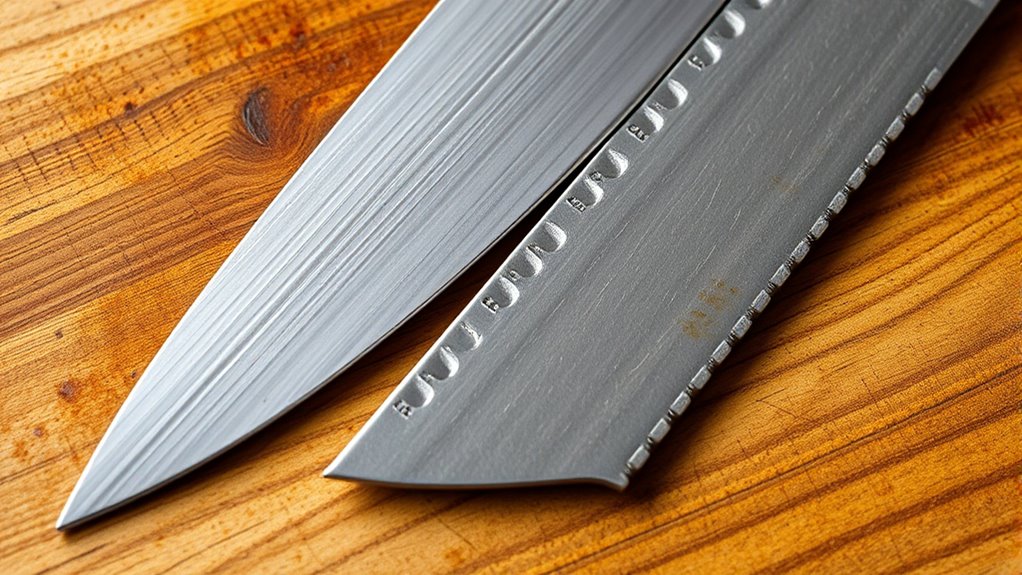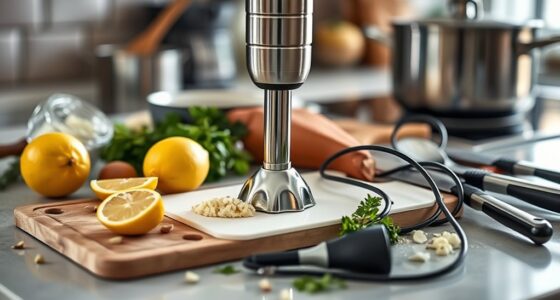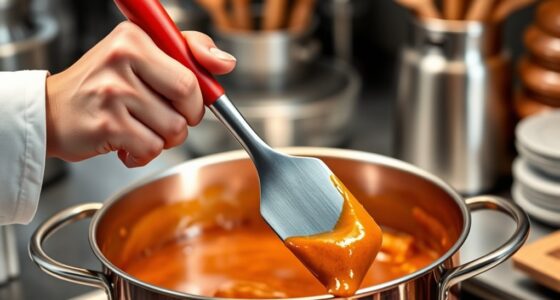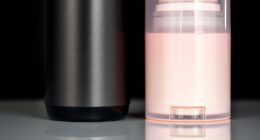Choosing between serrated and straight-edge knives depends on what you’re cutting. Straight-edge knives give you precise, clean slices suited for meats, vegetables, and cheeses. Serrated knives are better for crusty bread, tomatoes, and citrus, as they saw through tough skins with less pressure. Knowing your knives’ strengths helps you pick the right tool for each job. Keep exploring to discover how to get the most out of each knife type.
Key Takeaways
- Straight-edge knives provide precise, clean cuts ideal for meats, vegetables, and cheeses, while serrated knives excel at slicing bread and crusty foods.
- Serrated blades grip and tear through tough surfaces with less pressure, making them perfect for foods with hard exteriors.
- Straight-edge knives glide smoothly for controlled, finesse cuts, whereas serrated knives use a sawing motion suitable for tougher textures.
- Serrated knives tend to stay sharper longer but are harder to sharpen, unlike straight-edge knives that require regular honing and sharpening.
- Choose based on your most common foods: straight-edge for versatility and clean cuts, serrated for crusty or tough-skinned items.
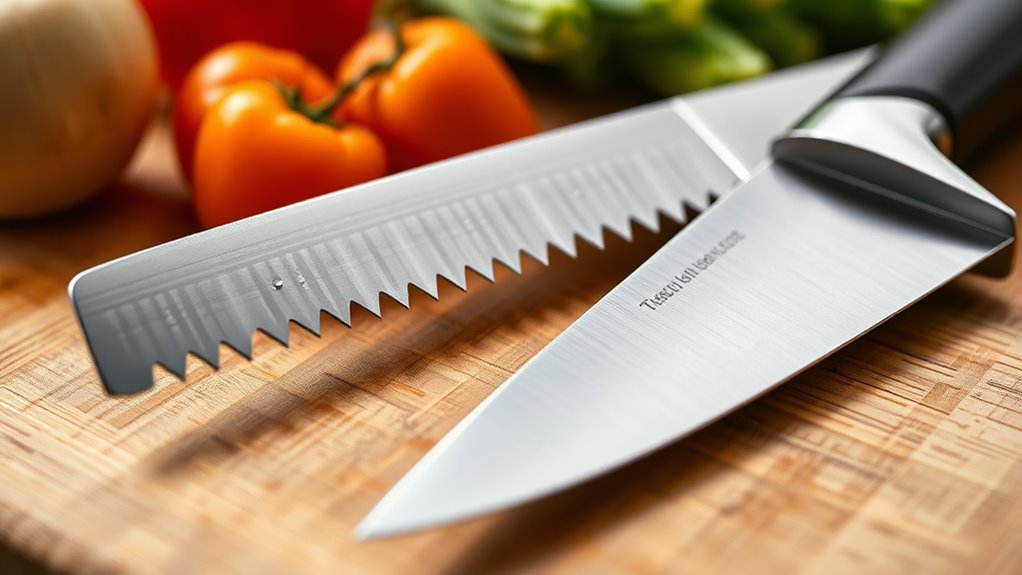
When choosing a kitchen knife, understanding the differences between serrated and straight-edge blades is essential. Each type serves a specific purpose, and knowing which to use can make your prep work more efficient and enjoyable. Straight-edge knives have a smooth, continuous blade that allows for precise, clean cuts. They excel at slicing through foods like meats, vegetables, and cheeses, where control and finesse are important. When you use a straight-edge knife, you’ll notice that it glides smoothly through the item, creating even slices that look professional. This makes them ideal for tasks that require accuracy, such as carving roast or chopping herbs.
Serrated knives, on the other hand, feature a scalloped, saw-like edge that grips and tears through tougher or crusty surfaces. They’re perfect for slicing bread, tomatoes, or citrus fruits, where a gentle sawing motion helps cut without crushing the delicate interior. The serrations help bite into hard exteriors while preventing the blade from slipping or squishing softer inside. If you’ve ever struggled to cut bread without squashing it or had difficulty slicing through a tough-skinned fruit, a serrated knife is your best friend. It requires less downward pressure, making it easier to get clean, even slices with minimal effort.
Your choice depends on the types of foods you most often prepare. If you frequently work with meats, vegetables, and cheeses, a straight-edge knife provides precision and control, allowing you to make delicate cuts that enhance presentation. For bread, tomatoes, or foods with tough exteriors, a serrated knife will deliver better results with less effort and less damage to the food. Keep in mind that serrated blades tend to be more durable over time; their teeth stay sharp longer because they do less contact with the cutting surface. Conversely, straight-edge blades may need more frequent sharpening but offer versatility and cleaner cuts. Additionally, proper care and maintenance can extend the lifespan of both types of knives, ensuring they perform optimally.
Another factor to contemplate is maintenance. Straight-edge knives require regular honing and occasional sharpening to keep them performing at their best. Serrated knives, however, are less prone to dulling quickly, but sharpening them can be more complicated and often requires special tools or professional service. Ultimately, having both types in your kitchen can cover all your cutting needs, giving you the precision of a straight-edge for most tasks and the serrated edge for bread and tough-skinned produce. By understanding their differences, you can select the right knife for each job, making your cooking smoother, safer, and more satisfying.
Frequently Asked Questions
How Long Do Serrated Knives Typically Last Before Sharpening?
You can expect serrated knives to last about 6 months to a year before needing sharpening, depending on how often you use them and what you cut. Unlike straight-edge knives, their serrations stay sharp longer because they cut with the teeth rather than the entire blade. However, when they do become dull, sharpening can be tricky and often requires professional help or specialized tools to restore their cutting edge effectively.
Are Straight-Edge Knives Better for Precision Cuts?
Yes, straight-edge knives are better for precision cuts because their smooth, sharp blade allows for more control and accuracy. You can make clean, precise slices, especially when preparing delicate ingredients like herbs or garnishes. Unlike serrated knives, which excel at cutting through rough or crusty surfaces, straight-edge knives give you the finesse needed for detailed work, making them ideal for tasks requiring a steady, exact hand.
Can I Use a Serrated Knife for Dicing Vegetables?
You can use a serrated knife for dicing vegetables, but it’s not ideal. Serrated blades excel at cutting soft or crusty foods like bread or tomatoes, while straight-edge knives give you more control for precise, clean dicing. If you want even-sized, neat cubes, a sharp straight-edge knife is your best choice. A serrated knife might crush or tear delicate vegetables, making it harder to achieve a uniform cut.
Which Type of Knife Is Easier to Maintain?
A stitch in time saves nine, and when it comes to maintenance, straight-edge knives are easier to keep sharp and in good condition. You can hone and sharpen them regularly with a whetstone or sharpening steel, ensuring a clean cut every time. Serrated knives, on the other hand, require more specialized tools and skills to maintain their teeth, making them less convenient for frequent upkeep.
Are There Specific Foods Better Suited for Serrated or Straight-Edge Knives?
You’ll find that serrated knives excel at slicing foods with tough exteriors and soft insides, like bread, tomatoes, and citrus fruits. Straight-edge knives work better for clean, precise cuts on meats, herbs, and vegetables, especially when you need control and finesse. Using the right knife for specific foods makes your prep easier and results in better presentation. So, match your knife to the food for ideal results and efficiency.
Conclusion
So, whether you prefer the saw-like bite of a serrated knife or the clean, controlled cut of a straight-edge, pick what suits your kitchen style. Just like a trusty Swiss Army knife in your pocket, the right knife makes all the difference. Remember, a good knife is an investment—think of it as your culinary Excalibur. Choose wisely, and your kitchen adventures will feel as legendary as King Arthur’s round table.
